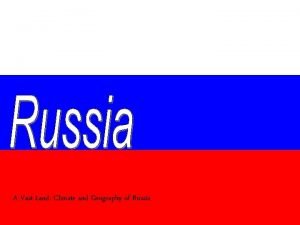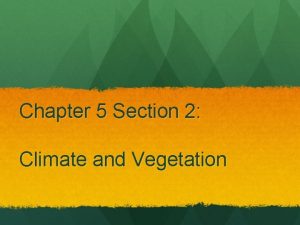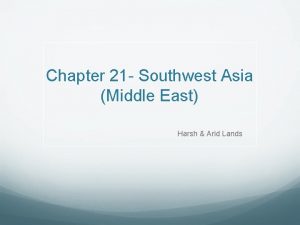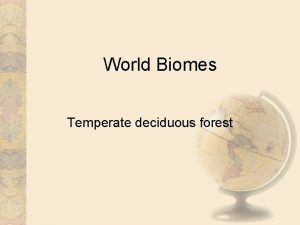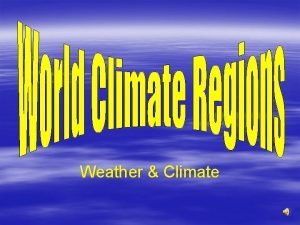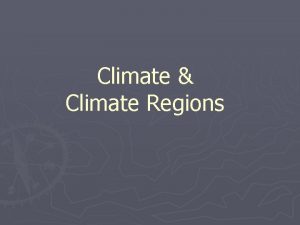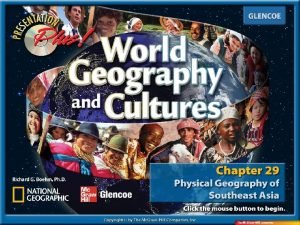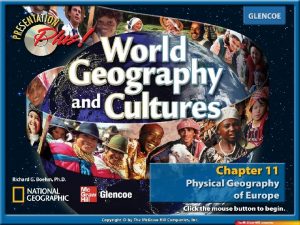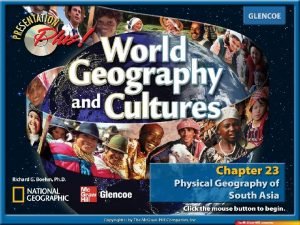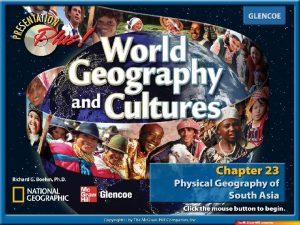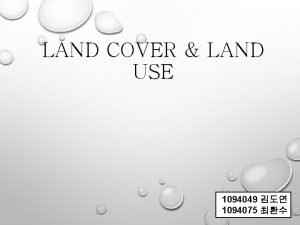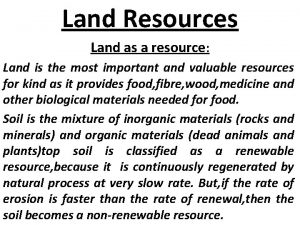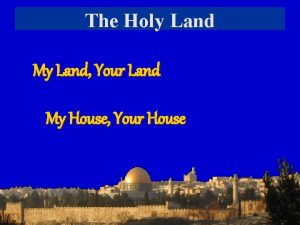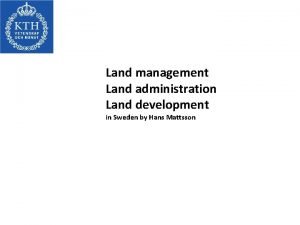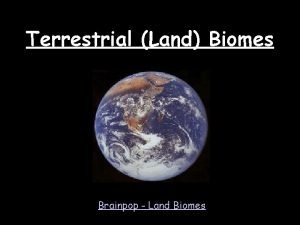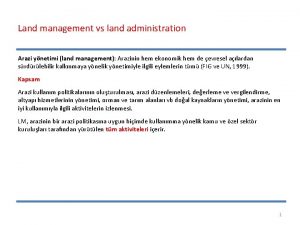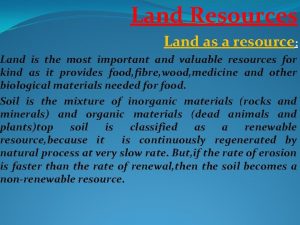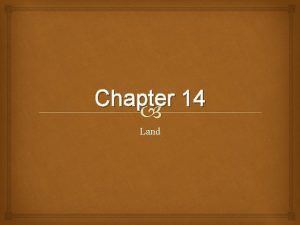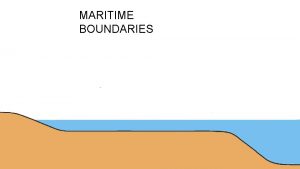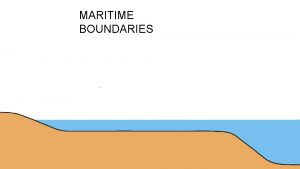Introduction Section 1 The Land Section 2 Climate























































- Slides: 55


Introduction Section 1: The Land Section 2: Climate and Vegetation Visual Summary

A study of the physical geography of Australia, Oceania, and Antarctica reveals a region of extreme differences—from the dry Australian Outback to the volcanic islands of the Pacific to the cold ice cap of Antarctica. Each of these subregions offers unique opportunities for economic growth, tourism, and scientific research.

Section 1: The Land The physical environment affects people and their activities. Australians have adapted to life in a country with large expanses of dry, flat land. People in Oceania take advantage of the volcanic soil of many of the islands.

Section 2: Climate and Vegetation The physical environment affects people and their activities. Australia is characterized by several different climates, while most of Oceania has a tropical wet climate and New Zealand has a marine west coast climate. Each type of climate affects human activities.


The Land Australians have adapted to life in a country with large expanses of dry, flat land. People in Oceania take advantage of the volcanic soil of many of the islands.

The Land • artesian well • coral • atoll • lagoon • virtually • display

The Land A. Australia B. Great Dividing Range C. Nullarbor Plain D. Murray River E. Darling River F. Oceania G. Melanesia

The Land H. Micronesia I. Polynesia J. New Zealand K. North Island L. South Island

The Land Name the only place on earth that is both a continent and a country? A. Antarctica B. Australia C. Africa A. A B. B C. C

Australia’s physical environment contributes in various ways to the country’s economy. • Mountains and Plateaus: – Great Dividing Range – Western Plateau – Nullarbor Plain

Australia (cont. ) • The Great Dividing Range and the Western Plateau are separated by the Central Lowlands. • The world’s largest coral reef—the Great Barrier Reef—lies along the northeastern coast. • Agriculture is important to the country: – Wheat, barley, fruit, sugarcane – Cattle, sheep, chickens

Australia (cont. ) • Rich mineral resources: – One-fourth of the world’s bauxite – Opals – Coal, iron ore, lead, zinc, gold, nickel and petroleum Australia: Elevation Profile

Farmers use which source of water for their livestock? A. The Great Artesian Basin B. Murray River C. Darling River D. Sea water A. B. C. D. A B C D

Oceania Life on the islands of Oceania is influenced by the type of island physical process by which it was formed. • Oceania’s islands are classified into three groups based on: – Location – How the islands formed – The inhabitants’ cultures

Oceania (cont. ) • Three groups: – Melanesia – Micronesia – Polynesia

Oceania (cont. ) • Island types: – High—mountain ranges split by valleys – Low—atolls and lagoons – Continental—larger islands

Which type of island best supports human life? A. High B. Low C. Continental A. A B. B C. C

New Zealand People in New Zealand utilize elements of the physical environment to make a living. • North Island: – Golden beaches, ancient forests, rich soil, freshwater lakes – Mount Ruapehu

New Zealand (cont. ) • South Island: – Southern Alps – Mount Cook – Sparkling lakes – Canterbury Plains

New Zealand’s physical environment allows which of the following to occur? A. Farming B. Raising livestock C. Using hydroelectric power D. Using geothermal energy E. All of the above A. B. C. D. E. A B C D E


Climate and Vegetation Australia is characterized by several different climates, while most of Oceania has a tropical wet climate and New Zealand has a marine west coast climate. Each type of climate affects human activities.

Climate and Vegetation • wattle • doldrums • typhoon • manuka • framework • occupy

Climate and Vegetation A. Western Plateau B. Southern Alps

Climate and Vegetation The vegetation of Australia is primarily which of the following? A. Tropical rain forest B. Temperate grassland C. Desert scrub and desert waste D. Deciduous forest A. B. C. D. A B C D

Australia Variations in rainfall affect Australian’s climate and vegetation. • Climate and vegetation vary greatly: – Tropical (humid subtropical, Mediterranean, marine west coast)—northeast – Desert and steppe—interior

Australia (cont. ) – Midlatitude temperate—eastern, southern, and southwestern coasts Australia and Oceania: Natural Vegetation

What causes the significant changes in climate and vegetation throughout Australia? A. Wind currents B. Differences in rainfall C. Mountain ranges D. All of the above A. B. C. D. A B C D

Oceania and New Zealand Oceania is characterized by a tropical wet climate, while New Zealand experiences a more temperate marine west coast climate. • Seasons throughout most of Oceania alternate between wet and dry. • The doldrums occupy a narrow band near the equator.

Oceania and New Zealand (cont. ) • Ocean winds warm New Zealand in the winter and cool it in the summer, preventing temperature extremes. • Geographic differences also cause climatic variations.

Which percentage of New Zealand’s indigenous plants are native only to New Zealand? A. 50% B. 70% C. 90% D. 100% A. B. C. D. A B C D


A. Great Dividing Range • Chain of hills and mountains stretching from Cape York Peninsula to Tasmania • Interrupts Australia’s otherwise flat landscape • Most of Australia’s rivers begin in this range. • Extends through several climate regions

B. Oceania • • • Three island clusters: Melanesia, Micronesia, and Polynesia Tropical wet climate High islands were formed by volcanoes. Low islands are atolls formed by the buildup of coral on the rim of submerged volcanoes. Continental islands were formed by rising and folding of the ocean floor and contain most of Oceania’s mineral resources.

C. Great Barrier Reef • Located along Australia’s northeastern coast • World’s largest coral reef • Home to multitudes of fish and other marine life

D. Central Lowlands • Located between Great Dividing Range and Western Plateau • Murray and Darling Rivers supply water that supports farming. • Great Artesian Basin provides vast amounts of underground water.

E. New Zealand • North Island South Island make up 90 percent of the country’s landmass. • North Island has central plateau with volcanoes and hot springs; South Island has Southern Alps and lakes carved by glaciers. • Marine west coast climate

F. Western Plateau • Also known as the Outback; an expanse of flat land in central and western Australia • Sparsely populated, but large ranches raise livestock here. • Includes Great Sandy, Great Victoria, and Gibson Deserts





July, August, and September

artesian well a bored well from which water flows up like a fountain

coral limestone deposits formed from the skeletons of tiny sea creatures

atoll ring-shaped island formed by coral building up along the rim of an underwater volcano

lagoon shallow pool of water at the center of an atoll

wattle woven framework made from acacia saplings by early Australian settlers to build homes

doldrums a frequently windless area near the Equator

typhoon a violent tropical storm that forms in the Pacific Ocean, usually in late summer

manuka small shrubs that grow in plateau regions of New Zealand

To navigate within this Presentation Plus! product: Click the Forward button to go to the next slide. Click the Previous button to return to the previous slide. Click the Return button to return to the main presentation. Click the Home button to return to the Chapter Menu. Click the Help button to access this screen. Click the Exit button or press the Escape key [Esc] to end the chapter slide show. Links to Maps in Motion, static maps and charts, and transparencies appear near the bottom of slides as they are relevant. Links to the Reference Atlas and Geography Online are located on the navigation bar of most screens.

This slide is intentionally blank.
 Climate change 2014 mitigation of climate change
Climate change 2014 mitigation of climate change Land and climate
Land and climate An area of land largely enclosed by higher land
An area of land largely enclosed by higher land High rocky land usually with steep sides
High rocky land usually with steep sides Chapter 15 section 2 climate and vegetation
Chapter 15 section 2 climate and vegetation Why is the middle east so dry
Why is the middle east so dry Chapter 13 atmosphere and climate change section 1
Chapter 13 atmosphere and climate change section 1 Hình ảnh bộ gõ cơ thể búng tay
Hình ảnh bộ gõ cơ thể búng tay Ng-html
Ng-html Bổ thể
Bổ thể Tỉ lệ cơ thể trẻ em
Tỉ lệ cơ thể trẻ em Gấu đi như thế nào
Gấu đi như thế nào Chụp tư thế worms-breton
Chụp tư thế worms-breton Hát lên người ơi alleluia
Hát lên người ơi alleluia Kể tên các môn thể thao
Kể tên các môn thể thao Thế nào là hệ số cao nhất
Thế nào là hệ số cao nhất Các châu lục và đại dương trên thế giới
Các châu lục và đại dương trên thế giới Công thức tiính động năng
Công thức tiính động năng Trời xanh đây là của chúng ta thể thơ
Trời xanh đây là của chúng ta thể thơ Mật thư tọa độ 5x5
Mật thư tọa độ 5x5 Làm thế nào để 102-1=99
Làm thế nào để 102-1=99 độ dài liên kết
độ dài liên kết Các châu lục và đại dương trên thế giới
Các châu lục và đại dương trên thế giới Thơ thất ngôn tứ tuyệt đường luật
Thơ thất ngôn tứ tuyệt đường luật Quá trình desamine hóa có thể tạo ra
Quá trình desamine hóa có thể tạo ra Một số thể thơ truyền thống
Một số thể thơ truyền thống Cái miệng nó xinh thế chỉ nói điều hay thôi
Cái miệng nó xinh thế chỉ nói điều hay thôi Vẽ hình chiếu vuông góc của vật thể sau
Vẽ hình chiếu vuông góc của vật thể sau Biện pháp chống mỏi cơ
Biện pháp chống mỏi cơ đặc điểm cơ thể của người tối cổ
đặc điểm cơ thể của người tối cổ V cc cc
V cc cc Vẽ hình chiếu đứng bằng cạnh của vật thể
Vẽ hình chiếu đứng bằng cạnh của vật thể Vẽ hình chiếu vuông góc của vật thể sau
Vẽ hình chiếu vuông góc của vật thể sau Thẻ vin
Thẻ vin đại từ thay thế
đại từ thay thế điện thế nghỉ
điện thế nghỉ Tư thế ngồi viết
Tư thế ngồi viết Diễn thế sinh thái là
Diễn thế sinh thái là Các loại đột biến cấu trúc nhiễm sắc thể
Các loại đột biến cấu trúc nhiễm sắc thể Bảng số nguyên tố
Bảng số nguyên tố Tư thế ngồi viết
Tư thế ngồi viết Lời thề hippocrates
Lời thề hippocrates Thiếu nhi thế giới liên hoan
Thiếu nhi thế giới liên hoan ưu thế lai là gì
ưu thế lai là gì Khi nào hổ mẹ dạy hổ con săn mồi
Khi nào hổ mẹ dạy hổ con săn mồi Sự nuôi và dạy con của hươu
Sự nuôi và dạy con của hươu Hệ hô hấp
Hệ hô hấp Từ ngữ thể hiện lòng nhân hậu
Từ ngữ thể hiện lòng nhân hậu Thế nào là mạng điện lắp đặt kiểu nổi
Thế nào là mạng điện lắp đặt kiểu nổi Chapter 14 land section 1
Chapter 14 land section 1 Essay structure introduction
Essay structure introduction Climate zones of the united states
Climate zones of the united states Deciduous forest climate
Deciduous forest climate Persuasive essay about global warming
Persuasive essay about global warming Factors affecting their climate
Factors affecting their climate Humid subtropical climate
Humid subtropical climate

